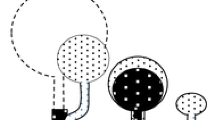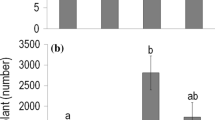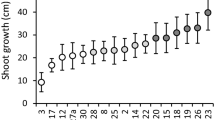Summary
Responses to defoliation were studied in two tallgrass prairie perennials (Andropogon gerardii and Panicum virgatum) established from seed at three densities. P. virgatum was also grown from transplanted rhizomes of established clones. Plants of both species displayed a continuum of responses to defoliation, from large reductions in biomass, tillering and seed production to significant increases in one or more performance measures. In crowded populations, defoliation shifted plants into subordinate positions within the competitive hierarchy. Plants competing intraspecifically and those that were initially small suffered more from defoliation than either plants grown at low density or those that were larger than their neighbors. At the highest plant density, the effects of defoliation or initial plant size were overshadowed by the effects of crowding. When defoliated and grown at similar densities, P. virgatum and A. gerardii grown from seed showed large reductions in biomass, seed production, and new rhizome production, but established P. virgatum ramets grown from rhizomes showed increases in these performance measures. Thus, herbivory may be particularly detrimental to P. virgatum during juvenile stages before perennating organs have developed. Overcompensation of P. virgatum clones in response to defoliation only occurred if all ramets within the clone were defoliated. In clones containing both defoliated and undamaged ramets, there were no differences in their performance, suggesting that genets are capable of integrating the effects of differential defoliation among shoots. Defoliated P. virgatum clones allocated a smaller fraction of their total biomass to new rhizomes, indicating that the short-term regrowth response following defoliation may incur a longer-term cost associated with gradual reduction in biomass of the perennating organs and reduced genet success.
Similar content being viewed by others
References
Albertson FW, Riegel DA, Launchbaugh JL (1953) Effects of different intensities of clipping on short grass in west-central Kansas. Ecology 34:1–20
Archer S, Detling JK (1984) The effects of defoliation and competition on regrowth of tillers of two North American mixed-grass prairie graminoids. Oikos 43:351–357
Belsky AJ (1986) Does herbivory benefit plants? A review of the evidence. Am Nat 127:870–892
Berendse F (1985) The effect of grazing on the outcome of competition between plant species with different nutrient requirements. Oikos 44:35–39
Biswell HH, Weaver JE (1933) Effect of frequent clipping on the development of roots and tops of grasses in prairie sod. Ecology 14:368–390
Caldwell MM, Richards JH, Johnson DA, Nowak RS, Dzurec RS (1981) Coping with herbivory: Photosynthetic capacity and resource allocation in two semiarid Agropyron bunchgrasses. Oecologia 50:14–24
Coley PD (1980) Effects of leaf age and plant life history patterns on herbivory. Nature 284:545–546
Conover WJ, Iman RL (1981) Rank transformations as a bridge between parametric and non-parametric statistics. Am Stat 35:124–129
Crawley MJ (1985) Reduction of oak fecundity by low-density herbivore populations. Nature 314:163–164
Dirzo R (1984) Herbivory: A phytocentric overview. In: Dirzo R, Sarukhan J (eds) Perspectives on Plant Population Ecology. Sinauer Associates, Sunderland, Mass, pp 141–165
Dyer MI, Detling JK, Coleman DC, Hilbert DW (1982) The role of herbivores in grasslands. In: Estes JR, Tyrl RJ, Brunken JN (eds) Grasses and Grasslands: Systematics and Ecology. Univ of Oklahoma Press, Norman, pp 255–295
Harper JL (1977) Population Biology of Plants. Academic Press, New York
Hartnett DC, Bazzaz FA (1983) Physiological integration among intraclonal ramets in Solidago canadensis L. Ecology 64:779–788
Hartnett DC, Bazzaz FA (1985) Integration of neighborhood effects by clonal genets in Solidago canadensis. J Ecol 73:415–427
Heichel GH, Turner NC (1983) CO2 assimilation of primary and regrowth foliage of red maple (Acer rubrum L.) and red oak (Quercus rubra L.): response to defoliation. Oecologia 57:14–19
Kinsman S, Platt WJ (1984) The impact of a herbivore upon Mirabilis hirsuta, a fugitive prairie plant. Oecologia 65:2–6
Lee TD, Bazzaz FA (1980) Effects of defoliation and competition on growth and reproduction in the annual plant Abutilon theophrasti. J Ecol 68:813–821
Louda SM (1984) Herbivore effect on stature, fruiting, and leaf dynamics of a native crucifer. Ecology 65:1379–1386
McKendrick JD, Owensby CE, Hyde RM (1975) Big bluestem and indiangrass vegetative reproduction and annual reserve carbohydrate and nitrogen cycles. Agro-Ecosystems 2:75–93
McNaughton SJ (1983) Compensatory plant growth as a response to herbivory. Oikos 40:329–336
Mueggler WF (1970) Influence of competition on the response of Idaho fescue to clipping. USDA For Serv Res Paper INT-73, 10
Mueggler WF (1972) Influence of competition on the response of bluebunch wheatgrass to clipping. J Range Mgmt 25:88–92
Olson BE, Richards JH (1988) Annual replacement of the tillers of Agropyron desertorum following grazing. Oecologia 76:1–6
Owen DF, Wiegert RG (1981) Mutualism between grasses and grazers: an evolutionary hypothesis. Oikos 36:376–378
Paige KN, Whitham TG (1987) Overcompensation in response to mammalian herbivory: the advantage of being eaten. Am Nat 129:407–416
Pitelka LF, Ashmun JW (1985) Physiology and integration of ramets in clonal plants. In: Jackson JBC, Buss LW, Cook RE (eds) Population Biology and Evolution of Clonal Organisms. Yale Univ Press, New Haven, pp 399–436
Rausher MD, Feeny P (1980) Herbivory, plant density, and plant reproductive success: The effect of Battus philenor on Aristolochia reticulata. Ecology 61:905–917
Schmid B, Puttick GM, Burgess KH, Bazzaz FA (1988) Clonal integration and effects of simulated herbivory in old-field perenials. Oecologia 75:465–471
Sokal RR, Rohlf FJ (1981) Biometry. WH Freeman and Co., New York
Stenseth NC (1983) Grasses, grazers, mutualism and coevolution: a comment about handwaving in ecology. Oikos 41:152–153
Weaver JE, Houghon VH (1939) Effects of frequent clipping on plant production in prairie and pasture. Am Midl Nat 21:396–414
Westoby M (1980) Relations between genet and tiller population dynamics: Survival of Phalaris tuberosa tillers after clipping. J Ecol 68:863–869
Whitham TG, Mopper S (1985) Chronic herbivory: Impacts on architecture and sex expression of Pinyon Pine. Science 228:1089–1090
Author information
Authors and Affiliations
Rights and permissions
About this article
Cite this article
Hartnett, D.C. Density- and growth stage-dependent responses to defoliation in two rhizomatous grasses. Oecologia 80, 414–420 (1989). https://doi.org/10.1007/BF00379045
Received:
Issue Date:
DOI: https://doi.org/10.1007/BF00379045




